1997 CHEVROLET ASTRO door lock
[x] Cancel search: door lockPage 10 of 404
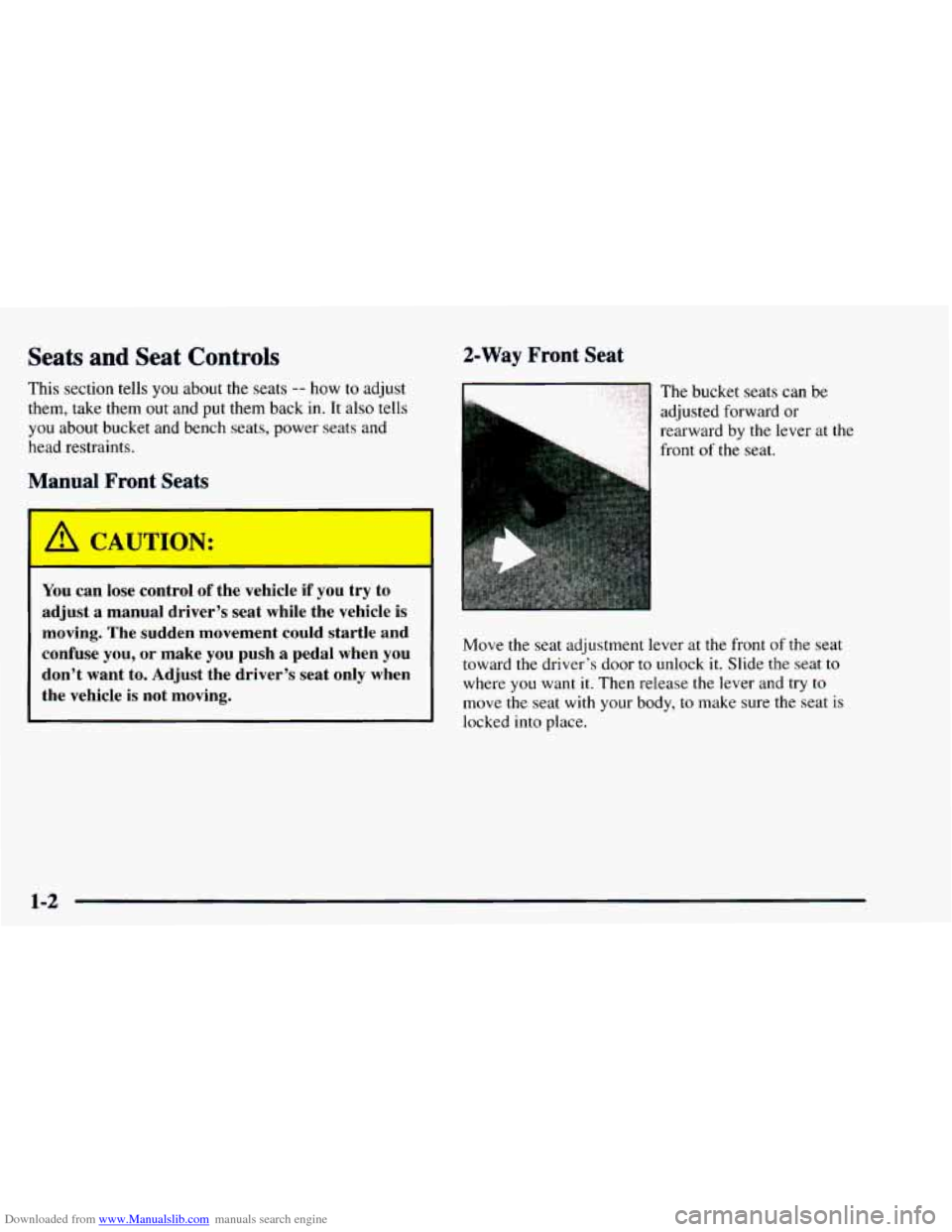
Downloaded from www.Manualslib.com manuals search engine Seats and Seat Controls
This section tells you about the seats -- how to adjust
them, take them
out and put them back in. It also tells
you about bucket and bench seats, power seats and
head restraints.
Mant-1 Front Seats
You can lose control of the v icle if you try to
adjust a manual driver’s seat while the vehicle is
2-Way Front Seat
The bucket seats can be
adjusted forward or
rearward by the lever at
the
front of the seat.
moving. The sudden movement could startle and
confuse you, or make you push a pedal when you
don’t want to. Adjust the driver’s seat only when the vehicle is not moving. Move the seat adjustment lever at the front of the seat
toward
the driver’s door to unlock it. Slide the seat to
where you want it. Then release the lever and try to
move the seat with your body, to make sure the seat is
locked into place.
1-2
Page 26 of 404
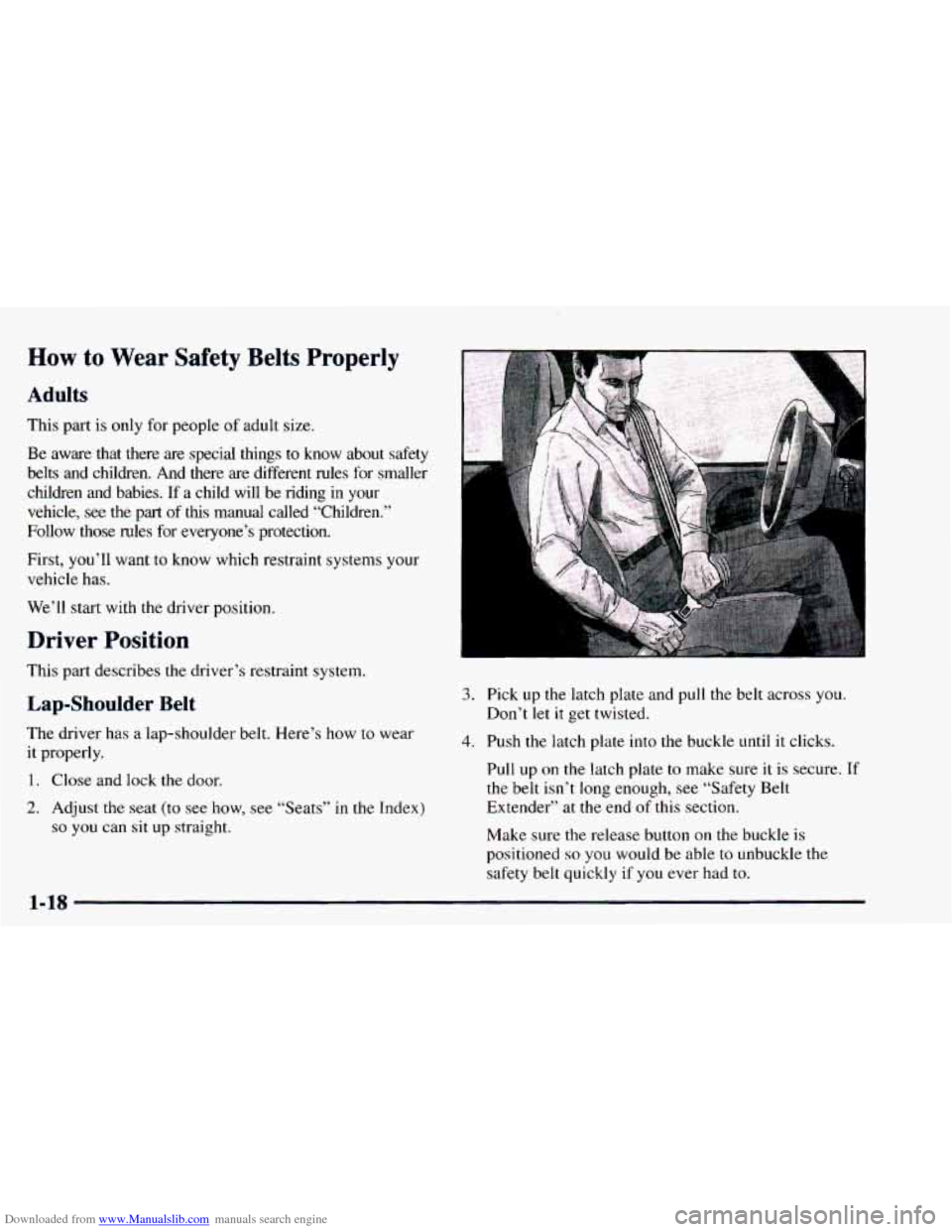
Downloaded from www.Manualslib.com manuals search engine How to Wear Safety Belts Properly
Adults
This part is only for people of adult size.
Be aware that there are special things to know about safety
belts and children. And there are different rules for smaller
children and babies. If a child will be riding in your
vehicle, see the
part of this manual called “Children.”
Follow those rules for everyone’s protection.
First, you’ll want to know which restraint systems your
vehicle has.
We’ll start with
the driver position.
Driver Position
This part describes the driver’s restraint system.
Lap-Shoulder Belt
The driver has a lap-shoulder belt. Here’s how to wear
it properly.
1. Close and lock the door.
2. Adjust the seat (to see how, see “Seats” in the Index)
so you can sit up straight.
“i
3. Pick up the latch plate and pull the belt across you.
Don’t let
it get twisted.
4. Push the latch plate into the buckle until it clicks.
Pull up
on the latch plate to make sure it is secure. If
the belt isn’t long enough, see “Safety Belt
Extender” at
the end of this section.
Make sure
the release button on the buckle is
positioned
so you would be able to unbuckle the
safety belt quickly
if you ever had to.
1-18
Page 75 of 404

Downloaded from www.Manualslib.com manuals search engine Section 2 Features and Controls
Here you can learn about the many standard and optional features on your vehicle, and information on starting,
shifting and braking. Also explained are the instrument panel and the warning systems that tell you if everything is
working properly
-- and what to do if you have a problem.
2-2
2-4 2-4
2- 6
2-7
2-
10
2- 12
2-
14
2- 15
2-15
2- 17
2-1 8
2- 19
2-22
2-22
2-23
2-24
2-26 Keys
Front
Doors
Rear Doors
Door Locks
Keyless Entry System
Sliding Door
Hatch
Theft New Vehicle “Break-In”
Ignition Positions
Starting Your Engine
Engine Coolant Heater (Option)
Automatic Transmission Operation
Locking Rear Axle All-Wheel Drive (Option)
Parking Brake
Shifting Into PARK (P)
Shifting Out
of PARK (P) 2-27
2-27
2-28
2-29
2-3
1
2-3 1
2-3 1
2-37
2-39
2-4
1
2-42
2-50
2-5
1
2-52
2-5
3
2-56
2-58
2-60 Parking
Over Things That Burn
Engine Exhaust
Running Your Engine While You’re Parked
Windows
Horn
Tilt Wheel (If Equipped)
Turn Signal/Multifunction Lever
Lamps Interior Lamps
Mirrors Storage Compartments
Ashtrays and Cigarette Lighter
Sun Visors
Accessory Power Outlets (Option)
Universal Transmitter (Option)
Instrument Panel
Instrument Panel Cluster
Warning Lights, Gages and Indicators
2-1
Page 77 of 404
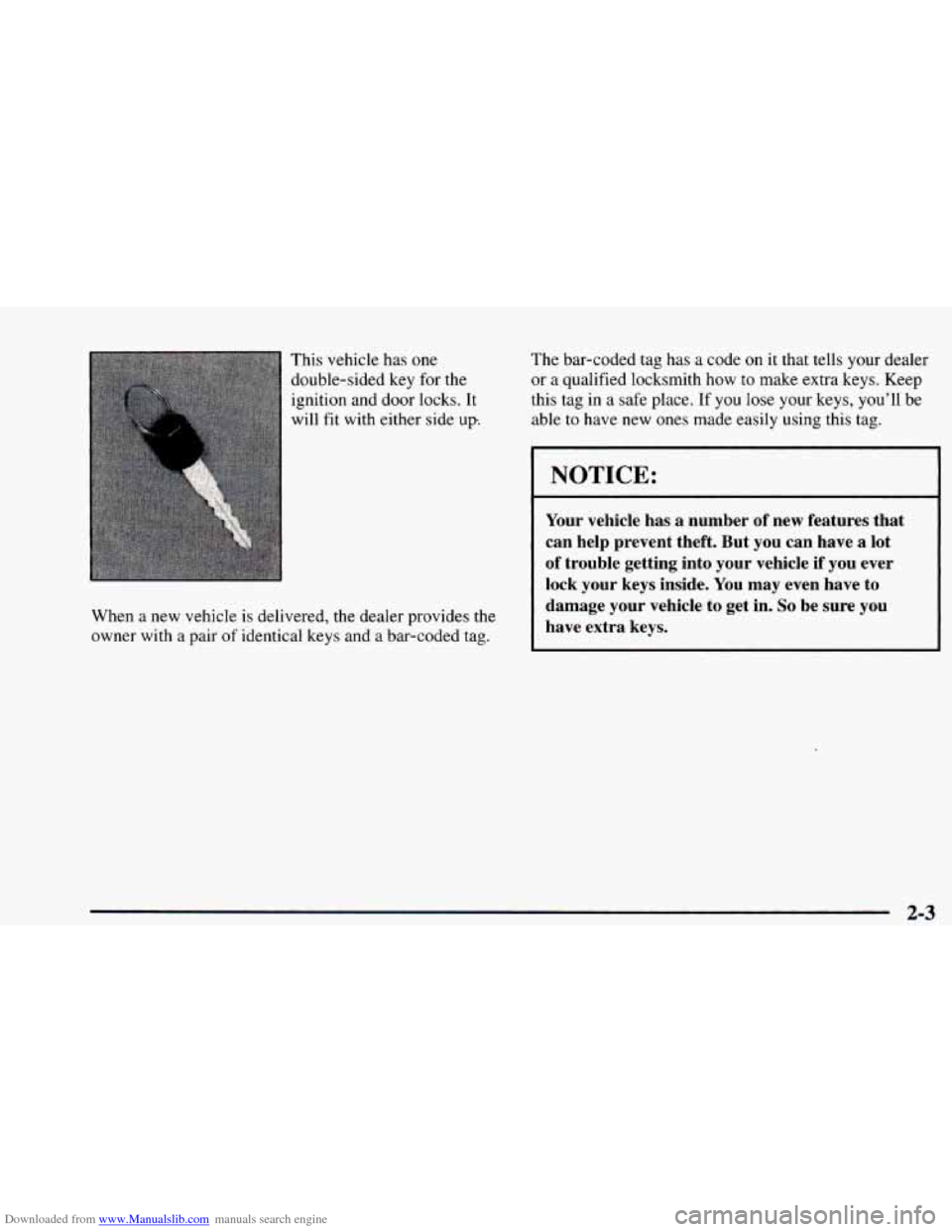
Downloaded from www.Manualslib.com manuals search engine This vehicle has one
double-sided key for the
ignition and door locks. It
will fit with either side
up.
The bar-coded tag has a code on it that tells your dealer
or a qualified locksmith how to make extra keys. Keep
this tag
in a safe place. If you lose your keys, you’ll be
able to have new ones made easily using this tag.
When
a new vehicle is delivered, the dealer provides the
owner with a pair
of identical keys and a bar-coded tag.
I NOTICE:
Your vehicle has a number of new features that
can help prevent theft. But you can have a lot
of trouble getting into your vehicle if you ever lock your keys inside. You may even have to
damage your vehicle to get in.
So be sure you
have extra keys.
2-3
Page 80 of 404
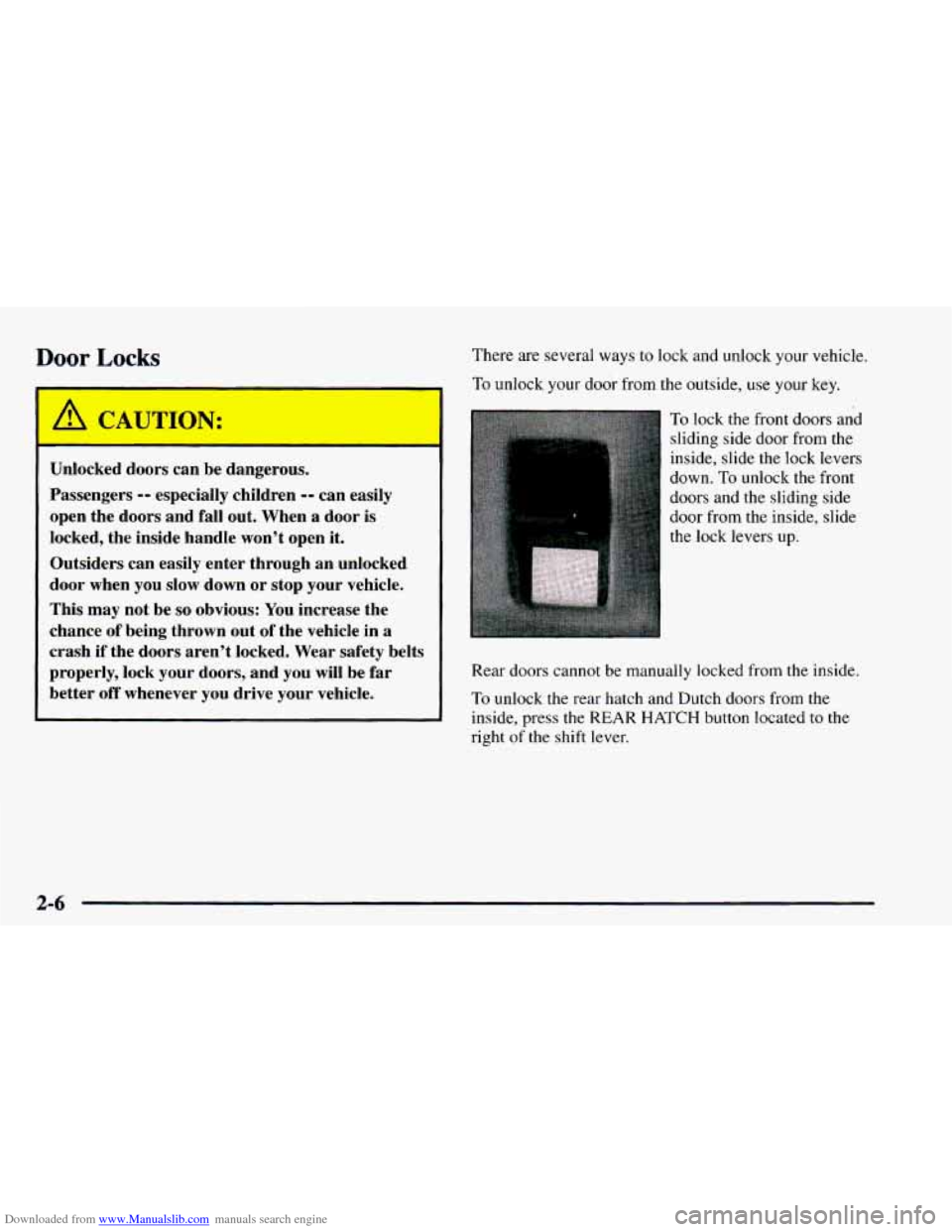
Downloaded from www.Manualslib.com manuals search engine Door Locks
Unlocked doors can be dangerous.
Passengers
-- especially children -- can easily
open the doors and fall out. When
a door is
locked, the inside handle won’t open it.
Outsiders can easily enter through an unlocked
door when you slow down or stop your vehicle.
This may not be
so obvious: You increase the
chance of being thrown out
of the vehicle in a
crash if the doors aren’t locked. Wear safety belts
properly, lock your doors, and you will be far
better
off whenever you drive your vehicle.
There are several ways to lock and unlock your vehicle.
To unlock your door from the outside, use your key.
To lock the front doors and
sliding side door from the
inside, slide the lock levers
down.
To unlock the front
doors and
the sliding side
door from the inside, slide
the lock levers up.
Rear doors cannot be manually locked from the inside.
To unlock the rear hatch and Dutch doors from the
inside, press the
REAR HATCH button located to the
right of the shift lever.
2-6
Page 81 of 404
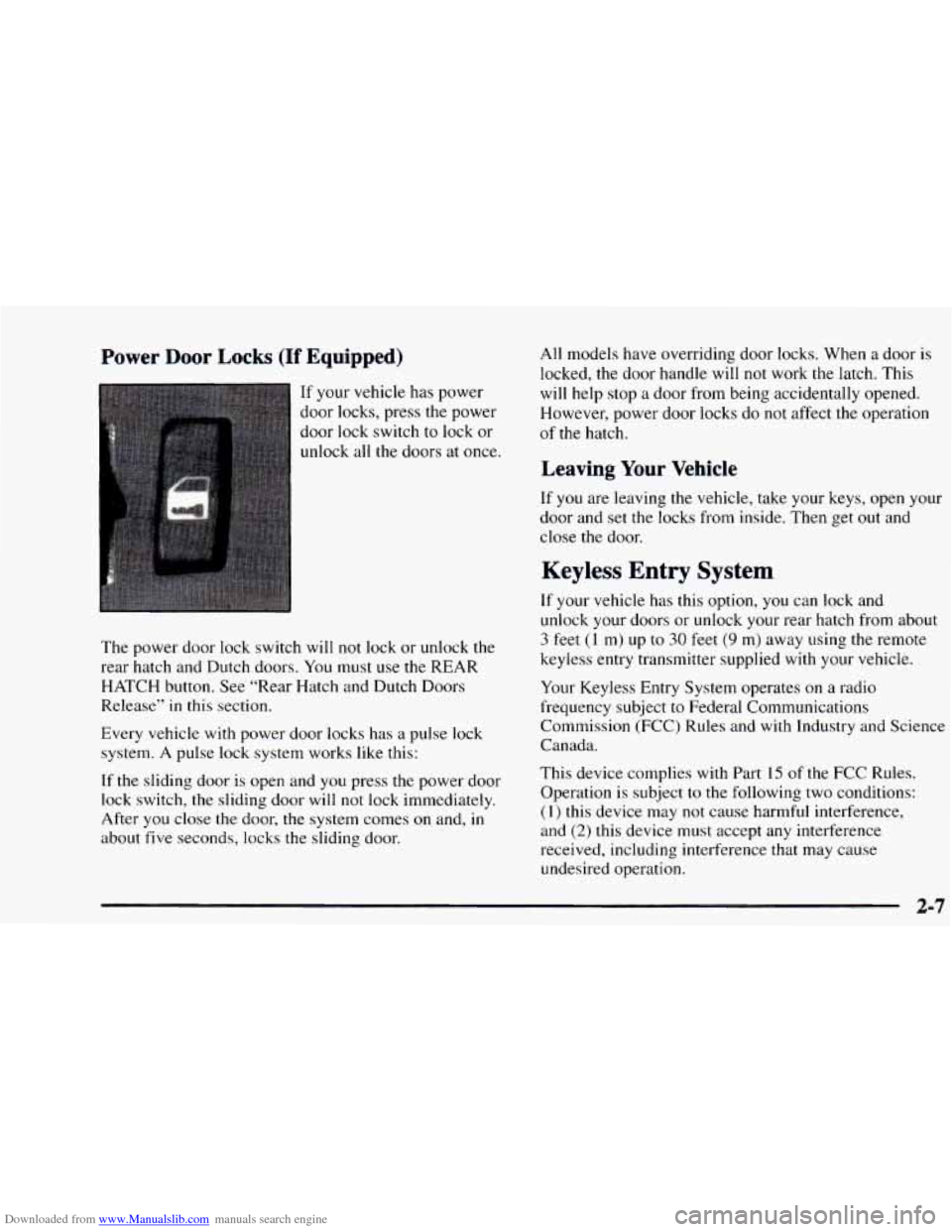
Downloaded from www.Manualslib.com manuals search engine Power Door LC ’-- (If Equipped)
If your vehicle has power
door locks, press the power
door lock switch to lock or
unlock all the doors at once.
The power door lock switch will
not lock or unlock the
rear hatch and Dutch doors.
You must use the REAR
HATCH button. See “Rear Hatch and Dutch Doors
Release” in
this section.
Every vehicle with power door locks has
a pulse lock
system.
A pulse lock system works like this:
If the sliding door is open and you press the power door
lock switch, the sliding door will
not lock immediately.
After you close the door, the system comes
on and, in
about five seconds, locks the sliding door. All
models have overriding door locks. When a door is
locked,
the door handle will not work the latch. This
will help stop a door from being accidentally opened.
However, power door locks
do not affect the operation
of the hatch.
Leaving Your Vehicle
If you are leaving the vehicle, take your keys, open your
door and set the locks from inside. Then get
out and
close the door.
Keyless Entry System
If your vehicle has this option, you can lock and
unlock your doors or unlock your rear hatch from about
3 feet (1 m) up to 30 feet (9 m) away using the remote
keyless entry transmitter supplied with your vehicle.
Your Keyless Entry System operates on a radio
frequency subject to Federal Communications
Commission (FCC) Rules and with Industry and Science
Canada.
This device complies with Part
15 of the FCC Rules.
Operation
is subject to the following two conditions:
(1) this device may not cause harmful interference,
and
(2) this device must accept any interference
received, including interference that may cause
undesired operation.
2-7
Page 82 of 404

Downloaded from www.Manualslib.com manuals search engine This device complies with RSS-210 of Industry and
Science Canada. Operation is subject
to the following
two conditions:
(1) this device may not cause
interference, and
(2) this device must accept any
interference received, including interference that
may cause undesired operation of
the device.
Changes or modifications
to this system by other than
an authorized service facility could void authorization to
use this equipment.
This system has a range of about
3 feet (1 m) up to
30 feet (9 m). At times you may notice a decrease in
range. This is normal for any remote lock control
system. If the transmitter does not work or if you have
to stand closer
to your vehicle for the transmitter to
work, try this:
Check to determine if battery replacement or
transmitter resynchronization is necessary. See
the instructions that follow.
Check the distance. You may be too far from your
vehicle. You may need to stand closer during rainy
or snowy weather.
Check the location. Other vehicles or objects may be
blocking
the signal. Take a few steps to the left or
right, hold the transmitter higher, and try again.
If you’re still having trouble, see your GM dealer or
a qualified technician for service. Changes
or modifications
to this system by other than an
authorized service facility could void authorization to
use this equipment.
Operation
When you press UNLOCK, the driver’s door will
unlock automatically. If
you press UNLOCK again
within five seconds, all doors will unlock. All doors
will lock when LOCK is pressed. The interior lamps
will come on whenever you lock or unlock
the doors.
See “Keyless Illumination’’
in the Index. Pressing
REAR 2X twice within three seconds, will unlock the
hatch or rear cargo doors.
Matching Transmitter(s) To Your Vehicle
Each remote keyless entry transmitter is coded to
prevent another transmitter from unlocking your vehicle.
If a transmitter
is lost or stolen, a replacement can be
purchased through your dealer. Remember to bring any
remaining transmitters with
you when you go to your
dealer. When
the dealer matches the replacement
transmitter
to your vehicle, any remaining transmitters
’ must also be matched. Once your dealer has coded the
new transmitter, the lost transmitter will not unlock your
vehicle. Each vehicle can have
only two transmitters
matched to it.
2-8
Page 84 of 404
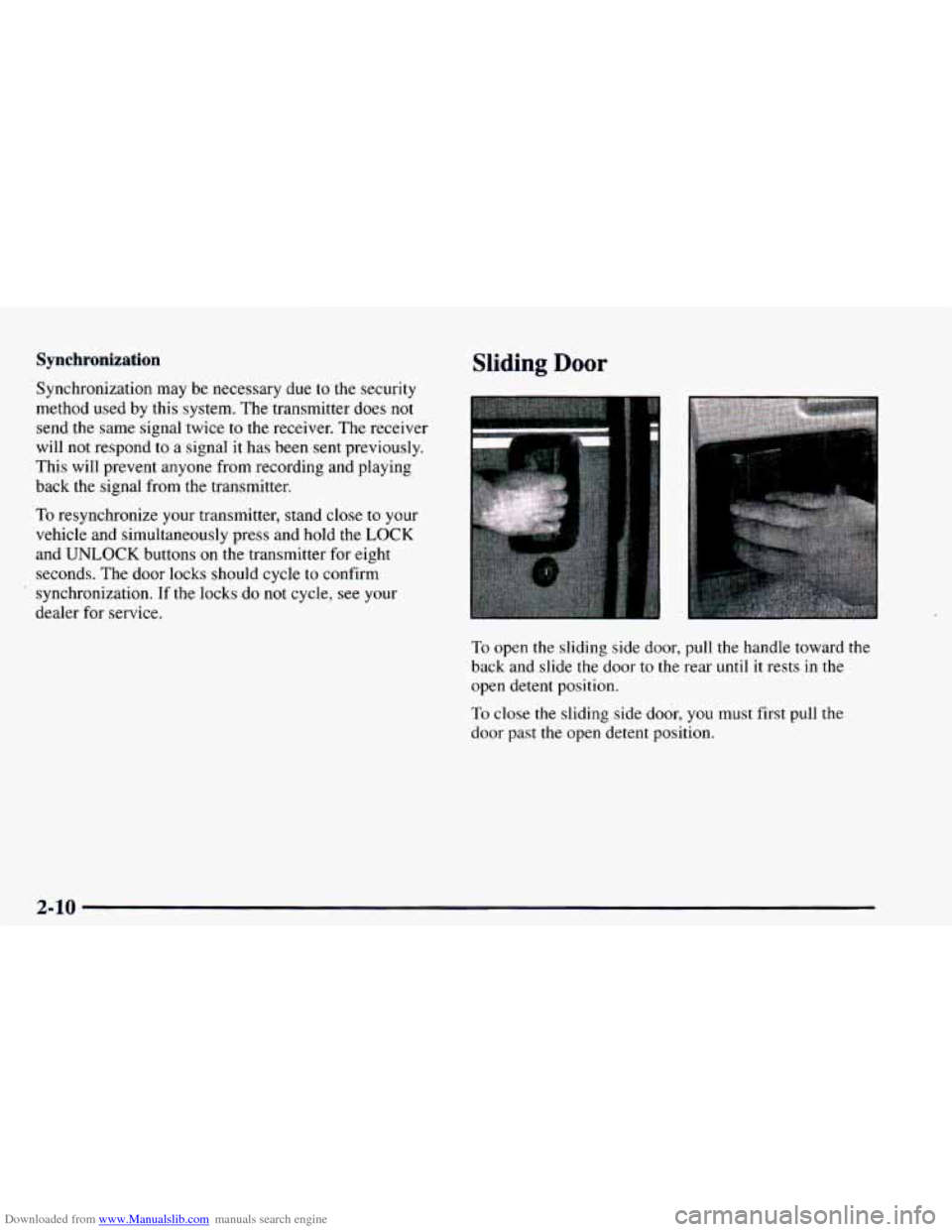
Downloaded from www.Manualslib.com manuals search engine Synchronization
Synchronization may be necessary due to the security
method used by this system. The transmitter does not
send the same signal twice
to the receiver. The receiver
will not respond to a signal it has been sent previously.
This will prevent anyone from recording and playing
back the signal from the transmitter.
To resynchronize your transmitter, stand
close to your
vehicle and simultaneously press and hold
the LOCK
and UNLOCK buttons on the transmitter for eight
seconds. The door locks should cycle to confirm
' synchronization. If the locks do not cycle, see your
dealer
for service.
Sliding Door
To open the sliding side door, pull the handle toward the
back and slide the door to the rear
until it rests in the
open detent position.
To close the sliding side door,
you must first pull the
door past the open detent position.
2-10